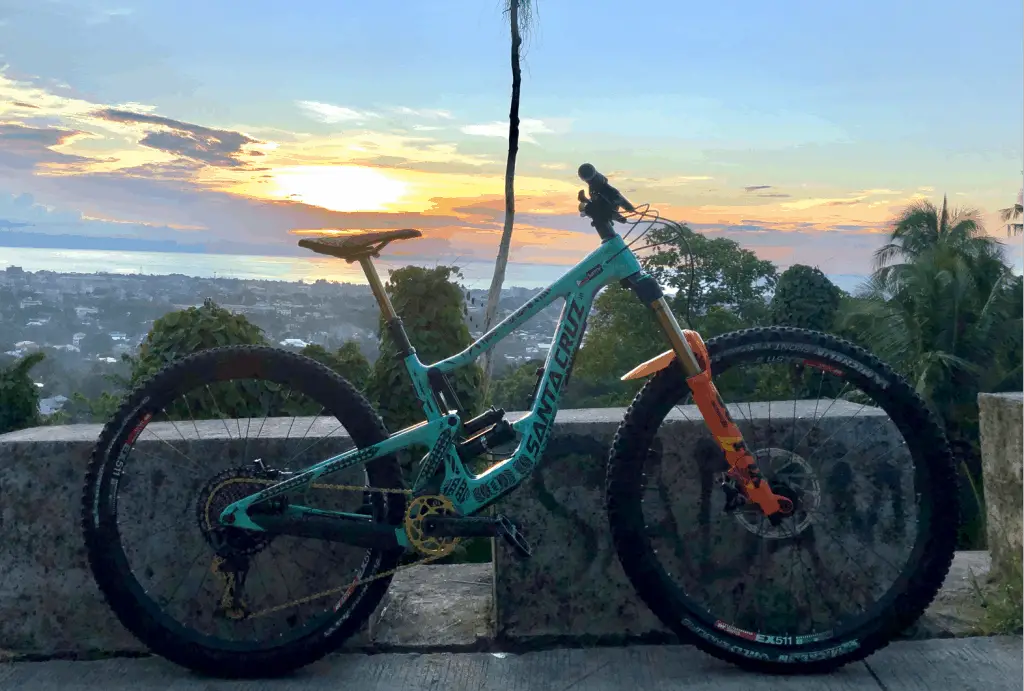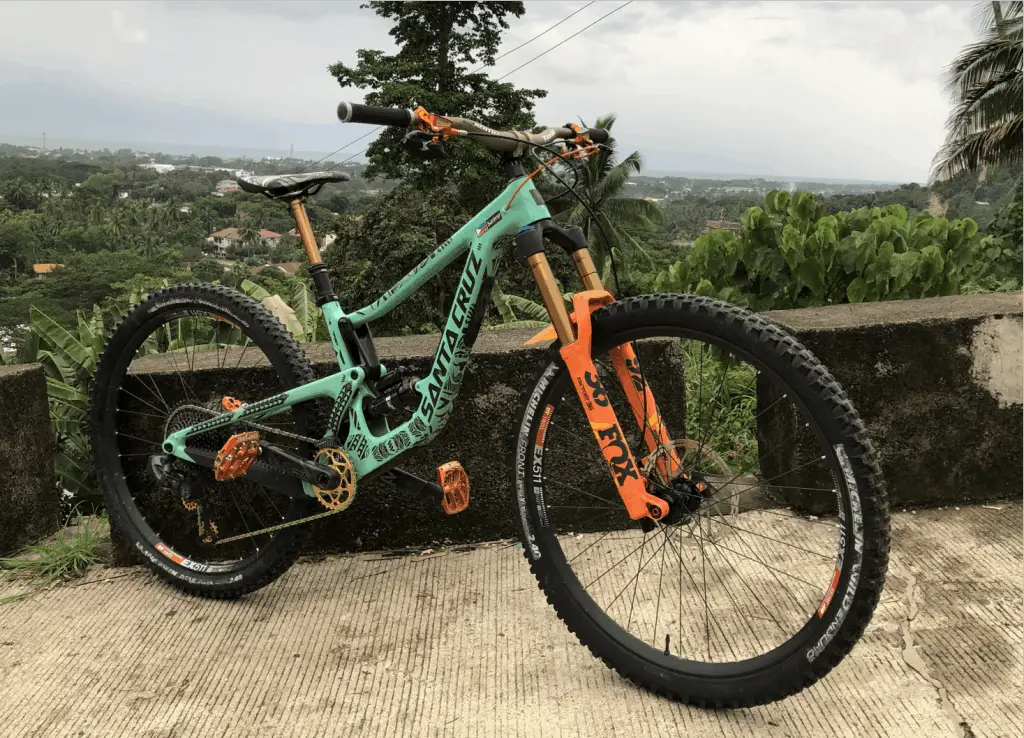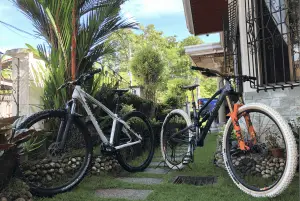Last Updated on October 31, 2023
This topic is quite controversial and has been a source of endless debate since the early days of biking. Especially when the topic is mountain biking, wherein the bike geometry and sizing are forever evolving, many people tend to get lost in bike sizing.
Bikes come in various forms, shapes, and sizes depending on the type of riding that you do. You cannot be efficient on a road bike if you take it mountain biking. The same applies to a downhill bike if you take it on endless uphill rides.
The Importance of Bike Sizing
Many years ago, people did not care about what bike size they rode. As long as it has two wheels, then it is good to go. As biking evolved, so did the sport.

As of today, efficiency is the key, even in the most extreme aspects of biking. Aside from having the perfect frame and adequate shocks, having the correct bike fit is also necessary.
If you ride a way smaller bike, your pedaling efficiency will dwindle significantly. If you use a bike that is way too big, it might be harder to handle. But if you use a bike that fits you perfectly, that is where comfort and efficiency would agree.
How Are Bikes Measured?
Different mountain bikes and bike disciplines have different sizing needs. Older bike sizing was based on how long the seat tube length is. This length refers to the length from the center of the bottom bracket.
Before, frames differed primarily because it is based on this measurement scheme. However, this sizing scheme is still being used today but with changes to the following:
- Reach and stack height
- Top tube length
- Wheelbase
- Chainstay length
- Head angle angle
- Bottom bracket height
Many of these aspects change as the bike frame size changes as well. Many people also believe that bike measurement is based on wheel size. And that 29er mountain bikes are only for those that stand 6 feet and above.
This is entirely wrong, as wheel bike size is preferred, and bike sizing is based on modern-day geometry.
Measuring the Bike
Reach and stack height
The reach and stack are determined by doing the following. For the stack, you must measure the height from the center of the BB to the horizontal level of the center of the top tube.
Now, to determine the reach, you must get the horizontal distance from the center of the top tube to the point that is perpendicular to the center of the bottom bracket.
Effective Top Tube Length
It refers to the horizontal distance from the top tube/head tube junction to the center of the seat tube. This key measurement used when sizing bicycles provide a standardized length relative to the bicycle frame design, even those with sloping top tubes.
The effective top tube acts as an indicator of how stretched out or upright the riding position will be. Generally, longer top tubes allow for a more aerodynamic position with less weight on the hands, while shorter top tubes provide a more upright riding stance.
It also standardizes the measurement to account for different frame designs by measuring the length of the seat to the bottom bracket center to the point where a horizontal line from the top of the head tube meets the seat tube axis. This gives riders an easy way to compare top tube lengths across various bicycle models.
Wheelbase
The wheelbase of the mountain bike is determined by measuring the distance from the center of the rear hub to the center of the front hub. This is important if you are buying kids’ bikes. Kids’ bikes need to be the right size for the child to ensure utmost safety.
Chainstay Length
Also called back center, the chainstay length is determined by measuring the center of the dropout or hub towards the center of the bottom bracket.
Head Angle
These two are probably one of the most significant measurements in modern geometry. You can measure this by getting the inside angle of the seat and head tubes relative to the ground. You can use your smartphone’s inclinometer to do so. A mountain bike frame has a slacker head angle than a road bike. This is because a road bike is made for flat roads, while mountain bikes are for uphills and downhills.
Bottom Bracket Drop
It is a measurement of the bike’s geometry indicating where the position of the bottom bracket shell is relative to the wheels. It is the vertical distance between the bottom bracket centre and the line connecting the axle centers of the front and rear wheels.
A lower bottom bracket drop means the bottom bracket shell and crankset are positioned closer to the ground. This generally provides better stability at slower speeds but can result in more frequent pedal strikes if riding over rough terrain. A higher bottom bracket has more standover clearance but can feel less stable at lower speeds.
Most road and gravel bikes have a bottom bracket drop between 65-70mm. Mountain bikes often have higher bottom bracket drops of 70mm or more to keep the cranks higher off the ground when riding technical trails. This measurement, along with bottom bracket height, affects the bike’s handling, stability, and pedal clearance over obstacles. Cyclists should consider their riding style when determining the ideal bottom bracket drop for a new bike.
Sizing Guide for Mountain Bike
There are many factors that you need to consider when it comes to bike sizing. This would include your height, preferences, and the type of bike your riding needs.

As discussed earlier, having the right bike frame size, whether it be a road bike or a mountain bike, will make your experience comfortable, fun, and very efficient.
To proceed with the sizing guide, you must first determine your riding style, your height, and the type of bike that you would ride.
Getting Your Height Measurement
The most common way to get the right bike size is to determine height. To do this, you will be measuring your height and the height of your inside leg. The first step to getting the right size bike is to stand flat against a wall and mark the top of your head with a pencil.
Make sure that it is level so that you will get your exact size bike height. If it is difficult for you to do so, you can ask for assistance from someone.
With your back still against a wall, get a book and let it stand in between your legs. This will simulate the top tube and measure the height of the book from the floor.
However, if your height is at the borderline of the bike size range, the reach measurement will be used as the deciding factor. This is determined by measuring your ape index using a tape measure.
- Tough enough for the toughest contractor, these tapes feature superior blade extension
Prices pulled from the Amazon Product Advertising API on:
Product prices and availability are accurate as of the date/time indicated and are subject to change. Any price and availability information displayed on [relevant Amazon Site(s), as applicable] at the time of purchase will apply to the purchase of this product.
What you need to do is measure your arm span, then subtract your height and compare it with the bike size. If your ape index is positive, then a larger bike size is the way to go for you. If it is negative, then a smaller bike size would work best. This is especially true for road bikes that have a small frame size.
Knowing Your Stand-Over Height
This aspect is significant because it allows your groin some clearance once your feet are planted on the ground. Generally, around 2cm of clearance is enough.
To determine the perfect standover height, this is technically getting your inside leg measurement minus two cm. You can use this as a guide when looking at geometry charts.
Conclusion
Knowing how bikes are measured means it would be easy to choose the right bike for your size. Especially if you engage in racing or aggressive riding, having the correct bike geometry will make you more efficient while on trails.

